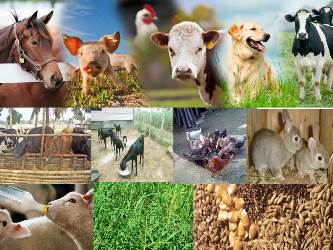



Received: 28-Nov-2022, Manuscript No. GJASLPAB-22-84098 ; Editor assigned: 02-Dec-2022, Pre QC No. GJASLPAB-22-84098 (PQ); Reviewed: 16-Dec-2022, QC No. GJASLPAB-22-84098 ; Revised: 23-Dec-2022, Manuscript No. GJASLPAB-22-84098 (R); Published: 30-Dec-2022, DOI: 10.35841/2408-5499.22.10.174
To guarantee that their needs for protein and energy are met during the winter, beef cows in gestation frequently require supplementation. However, it is challenging to stop individual animals fed in a group from consuming too much or too little food. This study's goal was to compare the effects of three levels of Tea Saponin (TS) to a TSfree control treatment to determine which had an intakelimiting effect on the consumption of pelleted feed. On a dry matter basis, commercial beef cows in late gestation (n=24) were randomly assigned to 1 of 4 treatments: 0% (A), 0.16% (B), 0.32% (C), or 0.64% (D) TS. The assignment of cows ensured that the treatment groups' initial mean body weights and body condition ratings were comparable. For 42 days, a supplement was given once daily via Calan gates at a rate of 2.5% of BW. Daily refusals were gathered to determine intake For pellet DMI, cow BW, and cow BCS, treatment differences were noted (P 0.0001).Treatment had no effect on cow hay intake, calf birth weight, or calf weaning weight (P>0.05).All treatments significantly differed in terms of dry matter intake of pellets as a percentage of body weight (DMIBW; P 0.0001), with intake decreasing as TS content rose. The DMIBW of all treatments varied significantly from day 0 to day 15, but for the remainder of the study, intakes stabilised between 1.75 and 2.5% DMIBW, with Treatment D consumption remaining substantially lower than that of the other treatments. It was discovered that Treatment D was effective at limiting pellet intake to an average DMIBW of 1.51%.This study found that adding TS to short-term pellets can reduce intake, emphasising it as a possible intake limiter product for beef cow farmers.
It is widely known that the nutritional state of the bovine mother during pregnancy affects the health and performance of the foetus. Reduced birth weights and lower calf survival rates have been linked to maternal nutrition limitation during late gestation.
Contrary to conflicting reports, nutritional supplementation of mothers during late gestation has been shown to boost weaning weights in both steer and heifer calves. This is true even if calves that were severely nutrient restricted in utero may have experienced compensatory preweaning growth. Along with growth, pregnat's nutritional health may also have an impact on the weight, softness, and fat accumulation of her offspring's carcasses. It is well recognised that insufficient prepartum nutrition in cows results in prolonged postpartum intervals and lower pregnancy rates. In order to treat nutritional inadequacies in pregnant, supplementation is occasionally necessary, especially if they are to be kept on poor quality forage over the winter. However, supplying a target quantity of energy or protein supplement to individual gestating cows is a frequent problem for beef producers. Since group living is the norm, it is challenging to avoid misuse or abuse of a supplement that is given and practically impossible to guarantee that each animal consumes a particular target amount of feed. Thankfully, using an intake limiter can assist guarantee that each animal consumes only a set amount of supplement proportional to its body weight. Salt, gypsum, calcium chloride, and phosphoric acid are typical limiters. Using the other compounds can present difficulties due to sulphur toxicity (gypsum), corrosivity (calcium chloride), and expensive handling requirements, even though salt are a relatively safe and affordable limiter (phosphoric acid).
When present in sufficient amounts, the bitter-tasting saponins contained in plants make the plant less palatable. They have varying numbers of sugar side chains and are structurally either steroidal or triterpenoid aglycone glycosides. There hasn't been much research done on saponins' impact on ruminants' feed intake and dietary preferences up to this point. Instead, uses of saponins in bovine nutrition have emphasised their antibacterial qualities, capacity to improve rumen fermentation, and capacity to increase nutrient absorption.
Therefore, the main goal of this study was to compare the intake-limiting effects of three concentrations of Tea Saponin (TS), a triterpenoid saponin isolated from the tea plant Camellia sinensis, to the consumption of pelleted supplements. Evaluation of the effects of various doses of limiter therapy on cow BW, cow BCS, fodder consumption, calf birth weight, and calf weaning weight were secondary goals.